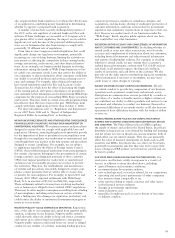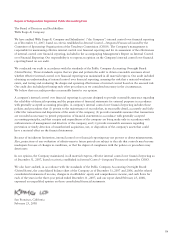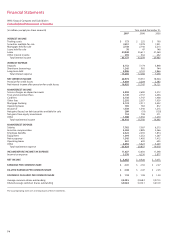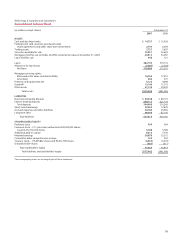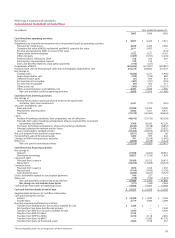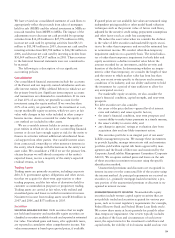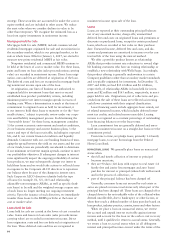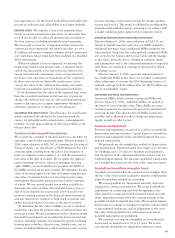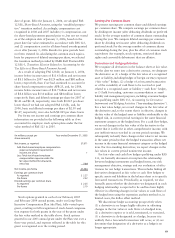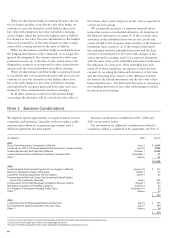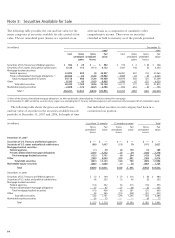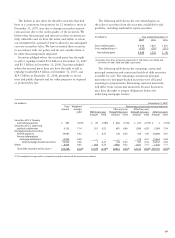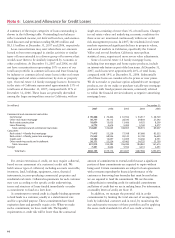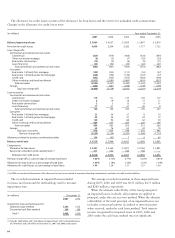Wells Fargo 2007 Annual Report Download - page 84
Download and view the complete annual report
Please find page 84 of the 2007 Wells Fargo annual report below. You can navigate through the pages in the report by either clicking on the pages listed below, or by using the keyword search tool below to find specific information within the annual report.81
loan agreement or (b) the loan is both well-secured and in the
process of collection and collectibility is no longer doubtful.
IMPAIRED LOANS We consider a loan to be impaired when,
based on current information and events, we determine that
we will not be able to collect all amounts due according to
the loan contract, including scheduled interest payments.
We assess and account for as impaired certain nonaccrual
commercial and commercial real estate loans that are over
$3 million and certain consumer, commercial and commercial
real estate loans whose terms have been modified in a troubled
debt restructuring.
When we identify a loan as impaired, we measure the
impairment based on the present value of expected future
cash flows, discounted at the loan’s effective interest rate,
except when the sole (remaining) source of repayment for
the loan is the operation or liquidation of the collateral.
In these cases we use an observable market price or the
current fair value of the collateral, less selling costs when
foreclosure is probable, instead of discounted cash flows.
If we determine that the value of the impaired loan is less
than the recorded investment in the loan (net of previous
charge-offs, deferred loan fees or costs and unamortized pre-
mium or discount), we recognize impairment through an
allowance estimate or a charge-off to the allowance.
ALLOWANCE FOR CREDIT LOSSES The allowance for credit losses,
which consists of the allowance for loan losses and the
reserve for unfunded credit commitments, is management’s
estimate of credit losses inherent in the loan portfolio at the
balance sheet date.
Transfers and Servicing of Financial Assets
We account for a transfer of financial assets as a sale when we
surrender control of the transferred assets. Effective January 1,
2006, upon adoption of FAS 156, Accounting for Servicing of
Financial Assets – an amendment of FASB Statement No. 140,
servicing rights resulting from the sale or securitization of
loans we originate (asset transfers), are initially measured at
fair value at the date of transfer. We recognize the rights to
service mortgage loans for others, or mortgage servicing
rights (MSRs), as assets whether we purchase the MSRs or
the MSRs result from an asset transfer. We determine the fair
value of servicing rights at the date of transfer using the pre-
sent value of estimated future net servicing income, using
assumptions that market participants use in their estimates
of values. We use quoted market prices when available to
determine the value of other interests held. Gain or loss on
sale of loans depends on (a) proceeds received and (b) the
previous carrying amount of the financial assets transferred
and any interests we continue to hold (such as interest-only
strips) based on relative fair value at the date of transfer.
To determine the fair value of MSRs, we use a valuation
model that calculates the present value of estimated future net
servicing income. We use assumptions in the valuation model
that market participants use in estimating future net servicing
income, including estimates of prepayment speeds (including
housing price volatility), discount rate, default rates, cost to
service (including delinquency and foreclosure costs), escrow
account earnings, contractual servicing fee income, ancillary
income and late fees. This model is validated by an independent
internal model validation group operating in accordance with
a model validation policy approved by Corporate ALCO.
MORTGAGE SERVICING RIGHTS MEASURED AT FAIR VALUE
Effective January 1, 2006, upon adoption of FAS 156, we
elected to initially measure and carry our MSRs related to
residential mortgage loans (residential MSRs) using the fair
value method. Under the fair value method, residential MSRs
are carried in the balance sheet at fair value and the changes
in fair value, primarily due to changes in valuation inputs
and assumptions and to the collection/realization of expected
cash flows, are reported in earnings in the period in which
the change occurs.
Effective January 1, 2006, upon the remeasurement of
our residential MSRs at fair value, we recorded a cumulative
effect adjustment to increase the 2006 beginning balance of
retained earnings by $101 million after tax ($158 million pre
tax) in stockholders’ equity.
AMORTIZED MORTGAGE SERVICING RIGHTS
Amortized MSRs, which include commercial MSRs and,
prior to January 1, 2006, residential MSRs, are carried at
the lower of cost or market value. These MSRs are amor-
tized in proportion to, and over the period of, estimated net
servicing income. The amortization of MSRs is analyzed
monthly and is adjusted to reflect changes in prepayment
speeds, as well as other factors.
Premises and Equipment
Premises and equipment are carried at cost less accumulated
depreciation and amortization. Capital leases are included in
premises and equipment at the capitalized amount less accu-
mulated amortization.
We primarily use the straight-line method of depreciation
and amortization. Estimated useful lives range up to 40 years
for buildings, up to 10 years for furniture and equipment,
and the shorter of the estimated useful life or lease term for
leasehold improvements. We amortize capitalized leased assets
on a straight-line basis over the lives of the respective leases.
Goodwill and Identifiable Intangible Assets
Goodwill is recorded when the purchase price is higher than
the fair value of net assets acquired in business combinations
under the purchase method of accounting.
We assess goodwill for impairment annually, and more
frequently in certain circumstances. We assess goodwill for
impairment on a reporting unit level by applying a fair-
value-based test using discounted estimated future net cash
flows. Impairment exists when the carrying amount of the
goodwill exceeds its implied fair value. We recognize impair-
ment losses as a charge to noninterest expense (unless related
to discontinued operations) and an adjustment to the carry-
ing value of the goodwill asset. Subsequent reversals of
goodwill impairment are prohibited.
We amortize core deposit intangibles on an accelerated
basis based on useful lives of 10 to 15 years. We review
core deposit intangibles for impairment whenever events


